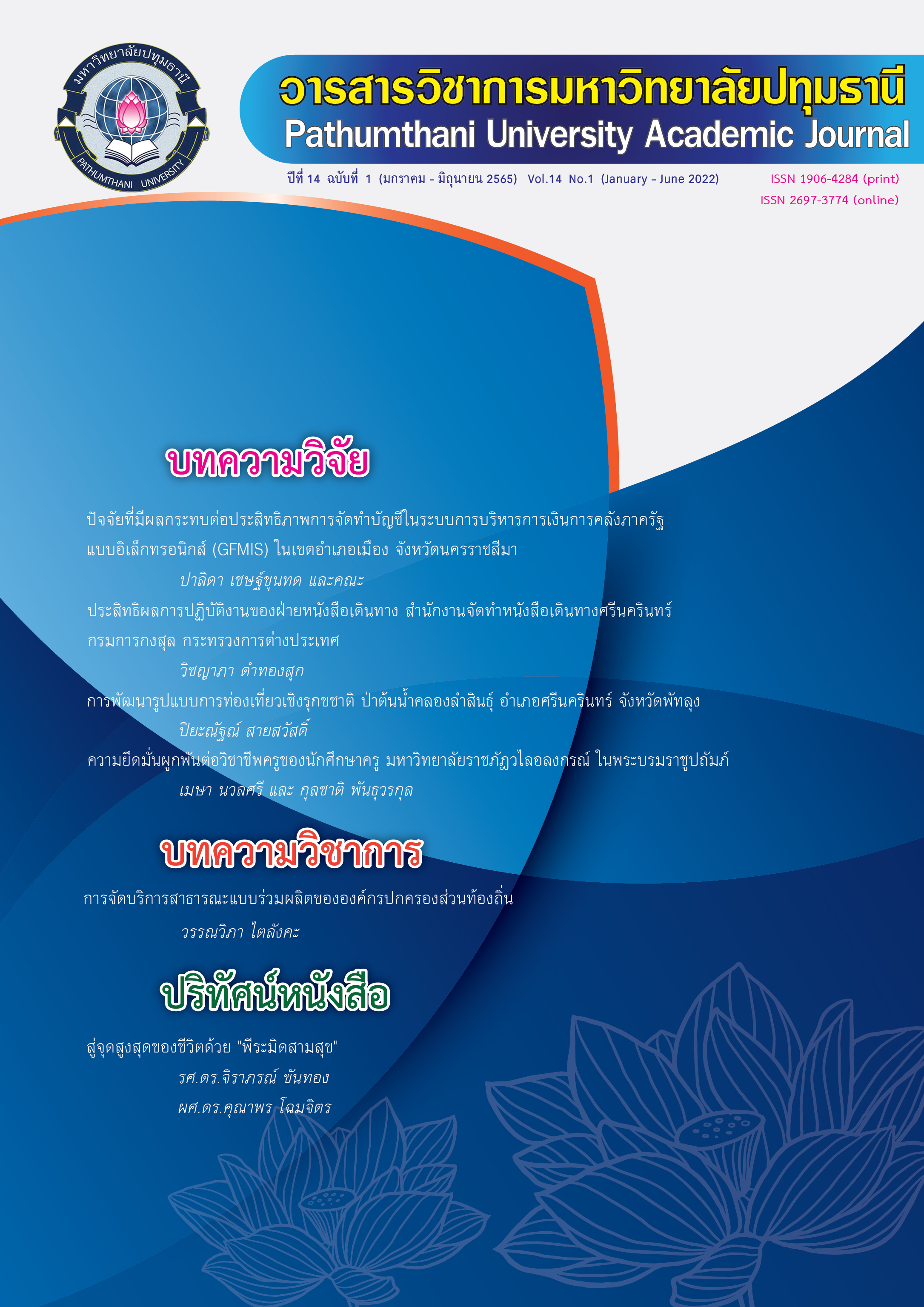READINESS TO USE ELECTRONIC DOCUMENT (E- DOCUMENT) SYSTEM OF NAKHONRATCHASIMA COLLEGE PERSONNEL
Keywords:
E-office System , Demand, PerceptionAbstract
This research aimed to study 1) investigates the application behavior on electronic document (e-Document) system of Nakhonratchasima College personnel. 2) level of perception in the use of the electronic document (e-Document) system of Nakhonratchasima College personnel and 3) level of readiness to use the electronic document (e-Document) system of Nakhonratchasima College personnel. The sample consisted of 144 persons in Nakhonratchasima College. The statistical analysis techniques used for data analysis were percentage, mean, standard deviation, T-Test, One-Way ANOVA. The results were summarized as:
1.The majority of the sample respondents were females with master's degree had a position as a lecturer and work experience between 3-5 years, behavior of using electronic document system 4-5 times per week.
2.Personnel of Nakhonratchasima College had awareness about electronic document (e- Document) system at the highest level. Considering the items, was found that the personnel of Nakhonratchasima College were aware that the electronic documentary system increased the efficiency of the work of the organization, followed by the knowledge of how to use the electronic document system and recognize the efficiency of the use of information technology respectively.
3.Personnel of Nakhonratchasima College are ready to use the electronic document (e- Document) system at the highest level, and when considering each item, was found that the personnel of Nakhonratchasima College were ready to access electronic document (e- Document) system and submission of documents to other relevant respectively.
4.The analysis the compare between demands to usability electronic document (e- Document) system of Nakhonratchasima College personal classified as sex, education level, position and experience different have a demand to usability electronic e-office system of Nakhonratchasima College personal differences statistically significant at the 0.05 level.
References
กุสุมาลย์ ประหา. (2557). คุณภาพด้านการทำงานของระบบสารบรรณอิเล็กทรอนิกส์ของมหาวิทยาลัยเทคโนโลยีราชมงคลอีสาน. การค้นคว้าอิสระปริญญาบริหารธุรกิจมหาบัณฑิต. มหาวิทยาลัยเทคโนโลยีราชมงคลธัญบุรี.
ดวงพร รัดสินทร. (2562). การรับรู้เทคโนโลยีที่มีผลต่อความตั้งใจใช้บริการการชำระเงินผ่าน คิวอาร์โค้ดของผู้บริโภคในเข9กรุงเทพมหานคร. การค้นคว้าอิสระปริญญาบริหารธุรกิจมหาบัณฑิต. มหาวิทยาลัยศรีนครินทรวิโรฒ.
ธานินทร์ ศิลป์จารุ. (2555). การวิจัยและวิเคราะห์ข้อมูลทางสถิติด้วย SPSS และ AMOS. (พิมพ์ครั้งที่ 13). กรุงเทพมหานคร : ห้างหุ้นส่วนสามัญบิสซิเนสอาร์แอนด์ดี.
นภดล แข็งการนา. (2564). การพัฒนาระบบสารบรรณอิเล็กทรอนิกส์สำหรับมหาวิทยาลัยราชภัฏนครสวรรค์. [ออนไลน์]. เข้าถึงได้จาก http://aritc.nsru.ac.th›aritckm›.
บุญชม ศรีสะอาด. (2556). การวิจัยเบื้องต้น. (พิมพ์ครั้งที่ 9). กรุงเทพมหานคร : สุวีริยาสาสน์.
ปริศนา มัชฌิมา และคณะ. (2555). พฤติกรรมและประสิทธิภาพการใช้ระบบสารบรรณ อิเล็กทรอนิกส์ (e-Office) ของมหาวิทยาลัยราชภัฏสวนดุสิต. คณะมนุษย์ศาสตร์และ สังคมศาสตร์. กรุงเทพมหานคร : มหาวิทยาลัยราชภัฏสวนดุสิต.
มานิตย์ กุศลคุ้ม. (2562). “ความพร้อมต่อการใช้ระบบสารบรรณอิเล็กทรอนิกส์ของบุคลากรมหาวิทยาลัยราชภัฏธนบุรี”. วารสารมหาวิทยาลัยราชภัฏธนบุรี. ปีที่ 13 ฉบับที่ 2. หน้า 171-181.
ศศิจันทร์ ปัญจทวี. (2560). ปัจจัยที่ส่งผลต่อการยอมรับการใช้ระบบสารสนเทศ กรณีศึกษาสถาบันการพลศึกษาวิทยาเขตเชียงใหม่. การศึกษาค้นคว้าอิสระปริญญาบริหารธุรกิจมหาบัณฑิต. มหาวิทยาลัยราชภัฏเชียงใหม่.
สารภี สหะวิริยะ. (2560). ปัญหาการใช้งานระบบเอกสารอิเล็กทรอนิกส์ (E-document) ของบุคลากร คณะวิทยาศาสตร์ และคณะวิศวกรรมศาสตร์ มหาวิทยาลัยสงขลานครินทร์ วิทยาเขตหาดใหญ่. สารนิพนธ์ปริญญารัฐประศาสนศาสตรมหาบัณฑิต. มหาวิทยาลัย สงขลานครินทร์.
Downloads
Published
How to Cite
Issue
Section
License
Copyright (c) 2022 สิทธิชัย ป้อมทอง

This work is licensed under a Creative Commons Attribution-NonCommercial-NoDerivatives 4.0 International License.
บทความที่ได้รับการตีพิมพ์เป็นลิขสิทธิ์ของวารสารมหาวิทยาลัยปทุมธานี
ข้อความที่ปรากฎในบทความแต่ละเรื่อง เป็นความคิดเห็นส่วนตัวของผู้เขียน กองบรรณาธิการไม่จำเป็นต้องเห็นด้วยเสมอไป และไม่มีส่วนรับผิดชอบใด ๆ ถือเป็นความรับผิดชอบของผู้เขียนแต่เพียงผู้เดียว



